#Sea otters diet
Text
Sea Otters: coastal habitat, diverse diet, and unknown facts. Discover their vital role in maintaining ecosystem balance and ongoing conservation efforts to protect these enchanting marine mammals.
#facts about Sea otters#Marine mammals#Sea otters#Sea otters classification#Sea otters diet#Sea otters facts#Sea otters habitat#Sea otters lifespan#The Junior Age
0 notes
Text
I am a survivor of Florida, having gone to college there for 4.5 years. There's a lot (a LOT) to not like about Florida, but the wildlife is not one of those things. So for this Wet Beast Wednesday, I'm gonna talk about the most famous Florida resident, the manatee. And why stop there? I'll discuss all the sirenians in one go.
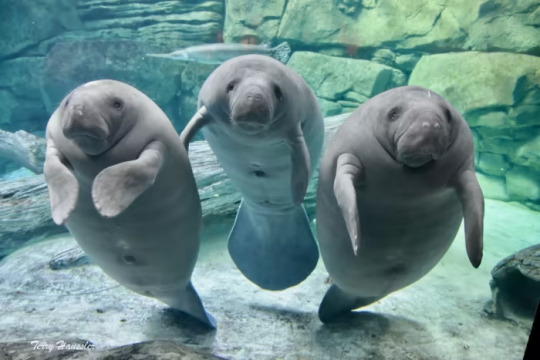
(image: three manatees facing the camera. They are rotund, resembling a potato in shape. Their heads are smaller and end in squarish snouts. They have two flippers at the front of the head. The tail is flat, wide, and round. They are grey all over)
The sirenians are a taxonomic order of marine mammals consisting of 4 living members: three species of manatee and the dugong. They are the only herbivorous order of marine mammals, a trait that has given the the nickname "sea cows". The name Sirenia comes from the sirens of greek myth. In the original story, the sirens were bird with the heads and breasts of women, but later stories turned them into mermaids and that's the version that's stuck. There are unconfirmed stories that European sailors (the most common story uses Christopher Columbus) mistook manatees for mermaids, which is why they're named after sirens.
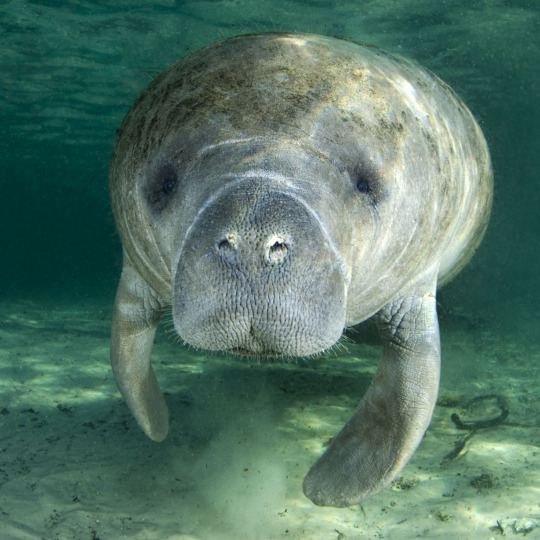
(image: a manatee facing the camera. Its face is visible, revealing two nostrils on a broad, flat shout covered in whiskers. It's eyes are located above the snout and are small and black. It is grey, but has patches of greenish algae growing on it)
Sirenians all have a pretty similar body plan. They are fusiform (bulky in the middle and narrower at the ends) and very bulky animals not built for speed. They don't ned to be fast (though are capable of short bursts of speed) because unlike other marine mammals, they are herbivorous. The vast majority of a sirenian's diet consists of sea grass and most of the rest is other aquatic plants. All species have been known to supplement their diet with invertebrates, mostly during times of poor food availability. When feeding, they move their snouts through the sediment, letting sensory bristles detect plants. They then use their flexible and muscular lips to pull up the sea grass, roots and all. While an individual can eat up to 15% of their body weight a day, they are known to seek out seagrass patches with higher nitrogen content instead of eating everything they can get. This reliance on seagrass limits the range of sirenians to shallow coastal areas, rivers, and estuaries in warm climates. Hearing and touch (with the bristles that cover their bodies) are their main senses. Their eyes are weak, making them almost blind. Sirenians are large, with the largest ever known, Stellar's sea cow, growing up to 10 meters (33 ft) and 11 tons. Mature sirenians are large enough to have no natural predators. Like all marine mammals not named sea otters, sirenians have a thick layer of blubber to keep them warm. Their bones are extremely dense and likely act as ballast to counteract the buoyancy of the blubber. In the marine mammal breath-holding competition, sirenians do pretty bad. They can hold their breath for about 15 minutes at max.
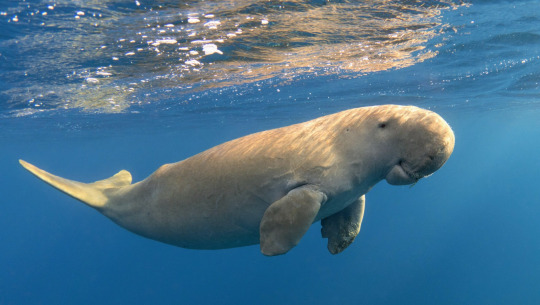
(image: a dugong. It is similar in appearance to a manatee, but skinnier. Its tail is a fluke with two points. Its head is larger and the snout and mouth point downwards)
Sirenian reproduction is somewhat poorly-understood. They only have a single calf at a time (with a gestation period of about a year) and mothers will raise them for one to two years. Calves mature quickly, reaching sexual maturity in around 2-5 years in manatees and 8 years in dugongs, though most females do not give birth until between 6 and 15 years. Their nipples are located behind the flippers, making a nursing calf appear to be sucking its mother's armpit. Sirenians are solitary animals who typically only congregate in groups when females are in estrus. Males are believed to compete for the right to mate and may engage in lekking. Lekking is when a male will claim a territory and mate with females in this territory while chasing opposing males out. Sirenians live long lives, with the oldest known individual being a female dugong that lived to 73. Despite how long they live, each female will only get pregnant a few times in her life.
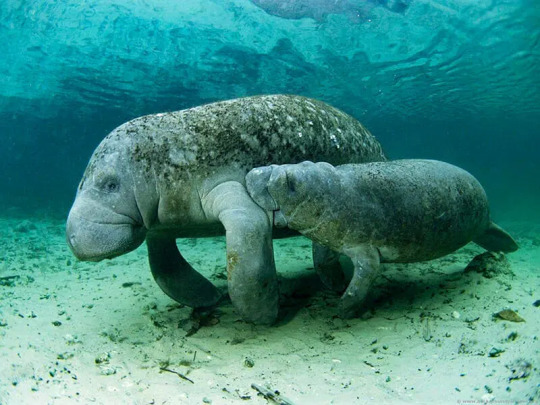
(image: a manatee mother with calf. The calf looks like a smaller version of the mother and is suckling, making it appear to be biting the mother's armpit)
As with all marine mammals, sirenians are descended from land mammals. The study of sirenian evolution has led to a surprising conclusion: the closest relatives of sirenians are elephants. It sounds weird, but there is substantial DNA evidence supporting this conclusion. In addition, the tusks of a dugong (see below) and flexible and prehensile lips of sirenians are based on the same structures as the tusks and trunks of elephants. It gets better, the next closest relative of both groups are the hyraxes, who look more like rodents than anything that should be related to an elephant or a manatee. All three are part of a clade called paenungulata, which is part of a clade called afrotheria. The other main group within afrotheria is afroinsectiphilia, which consists of aardvarks and various shrews. The afrotherian family reunions must be wild.

(image: a scientific diagram showing a cladogram of afrotheria and the groups within it. source)
The dugong (Dugong dugon) is the last surviving member of its family, which also included the now extinct giant Stellar's sea cow. The easiest way to tell a dugong apart from a manatee is its tail, which is shaped like a dolphin's fluke instead of the round tails of manatees. Internally, there are also multiple differences, many of them relating to the skull. The skull has a very distinct shape, with the upper jaw bending down at a sharp angle. The tip of the upper jaw has two short tusks emerging from it. These tusks are found in moth males and females, but develop differently. In males, they emerge when the calf reaches sexual maturity, while those of females only emerge later in life and sometimes not at all. It is believed that these tusks are used by males to fight over females, as males are often found with scars matching the shape of the tusks. Dugong teeth as simpler than those of manatees, being simple pegs. While manatee teeth will be replaced continuously through life, dugongs only get one set and have to make it count. Dugongs reach an average length of 3 m (10 ft) and 420 kg (930 lbs). Dugongs have the largest range of any sirenian, stretching from east Africa to the Solomon islands east of Australia. This range is fragmented rather than continuous and dugongs are separated into multiple isolated populations. The largest population is believed to exist in northern Australia.
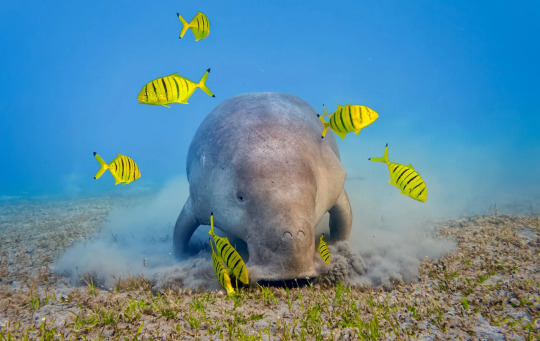
(image: a dugong feeding on seagrass, seen from the front. It's snout is being dragged through the sediment, leaving a cloud of dirt behind it. Small yellow fish surround it)
The west Indian manatee (Trichechus manatus) does not live in west India. It lives in North America. I dunno who named it, but you had one job. The species is divided into two subspecies: the Florida manatee (T. m. latriostris) found in the Gulf of Mexico and east coast of the United States, and the Antillean manatee (T. m. manatus) found in the Caribbean and down south to Brazil. The Antillean subspecies is much more poorly known compared to the Florida subspecies. The Florida manatee may be the most well-studied of all manatees due to the extensive conservation efforts regarding them since the 1970s. Like other manatees, the WI manatee has a round, paddle-like tail and fingernails on its flippers. Their diaphragms are divided into two hemidiaphragms, each of which contracts one lung. They have the northernmost territory of all manatees, which comes with some consequences. They are susceptible to stress and even death when exposed to water under 20 degrees C (68 F). They travel south during winter, usually to southern Florida, but conservationists still have to rehabilitate manatees harmed by cool water every year.
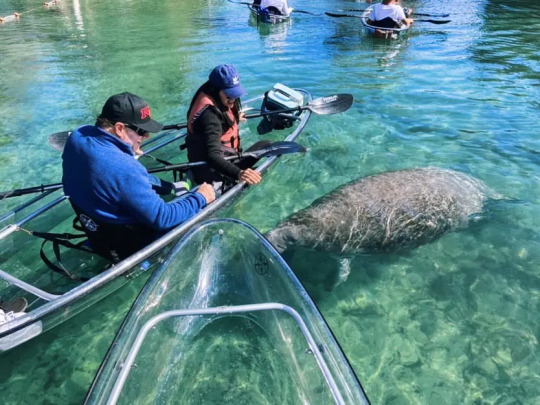
(image: tourists in transparent kayaks observing a west Indian manatee swim below them)
The Amazonian manatee (Trichechus inunguis) is the only sirenian that lives entirely in freshwater, residing in the Amazon river basin. They move seasonally inhabiting flooded areas during the wet season and lakes during the dry season. They fast during the dry season, subsisting off of their fat stores. There are believed to be multiple relatively isolated populations of Amazonian manatee, but studying them is difficult due to them preferring to live in areas away from humans. The Amazonian manatee is the smallest sirenian, reaching between 160 and 230 cm (5 ft 4 in to 7 ft 7 in) and 120 to 270 kg (265 to 595 lbs). Scientist Marc van Roosmalen has proposed the existence of a related species, the dwarf manatee, that lives only in one tributary of Aripuanã river, which is in the habitat range of the Amazonian manatee. Their existence is debated, but most manatee scientists think that they are misidentified juvenile Amazonian manatees.

(image: an Amazonian manatee with calf, seen from ahead and below. they have the same body plan as the above images, but are a darker grey with a white patch on the stomach)
The African manatee (Trichechus senegalensis) is the only species found in the old world, in west Africa from Senegal to Angola. They occupy the largest range of habitats of all sirenians, from tropical islands to flooded forests, to offshore sand flats, to lakes and rivers. They will swim up river during the wet season and back down during dry season. Some isolated populations live exclusively in rivers, never venturing out to sea. They are the most omnivorous of the sirenians, seeking out invertebrates to eat and stealing fish from nets. Many cultural groups in their range consider the African manatee sacred, some saying they used to be people and that killing one requires paying a penance. Mami Wata, a water spirit revered in throughout west, central, and south Africa, has been identified with manatees by some folklorists.

(image: an African manatee seen from the side in an aquarium. It looks almost identical to the west Indian manatee)
All sirenians are classified as vulnerable by the IUCN, except for the Antillean manatee, which is endangered. As they have few to no predators as adults, the primary threats for all sirenians come from humans. Boat strikes and getting tangled in nets kills and injures many individuals, possibly more than die of natural causes. This is not helped by them lacking fear responses to predators, meaning they don't flee from humans and boats. All species were historically hunted for their meat, blubber, and bones, reducing their populations. While all species are now legally protected, poaching and legal hunting by indigenous groups still occurs. They are also threatened by habitat loss as coastal development, pollution, and climate change reduces the range of seagrass. Damming has also reduced their ability to travel up rivers, cutting off valuable feeding ground. Learning about freshwater ecology will make you despise dams. In the United States, the west Indian manatee has become an icon of conservation, especially in Florida, where they have extensive legal protections. Controversially, the US government reduced their legal protections in 2017, much to the ire of many conservation groups. The manatee is the state marine mammal of Florida, presumably narrowly beating out dolphins and meth heads wandering around the everglades.

(image: two juvenile manatees who were abandoned by their mothers. They are being bottle fed by employees of the Cincinnati zoo. Ideally, they will be able to be released into the wild once weaned)
#wet beast wednesday#sirenia#manatee#dugong#west indian manatee#amazonian manatee#african manatee#marine biology#biology#zoology#ecology#animal facts#marine mammals
456 notes
·
View notes
Text

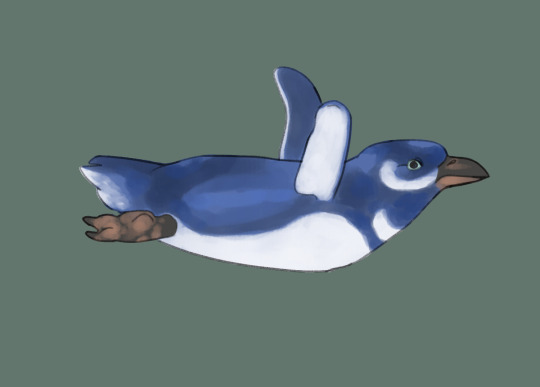

semi-aquatic coastal life of south Orus Hycea (Australia)
blue: Thylacetus (pouch whale)
thylacetus shares a common ancestor with thylacine, but split off millions of years ago. being a marsupial, it has a pouch that is now vestigial as it's counterproductive to carry infant young underwater. they have a carnivorous diet, preferring birds, fish, crabs and small mammals and lizards along the shore.
green: blue fairy penguin
a close relative of the fairy penguin, they favoured shallow waters and a diet of crustaceans and slow moving fish. their feathers are black with a blue sheen, and the main difference between their cousins are the white stripes on their face and neck as well as their thicker beak.
purple: clam seal
suggested by their name, they're actually an offshoot of sea otters that evolved convergently with seals after ending up on the other side of the globe. their back legs have remained mostly the same, unlike their front legs which are now flipper-like, similar to the thylacetus.
154 notes
·
View notes
Text

It's Wednesday and I have something to share! Thanks for the tags today @artsyunderstudy and @facewithoutheart, I'm so so excited by what you're both working on, two of my favourite WIPs in the game right now!
It's been a while, but I've finally finished up my draft of Chapter 4 of Hiding Out In The Open. Hoping to post by the middle of this month once my lovely beta readers have a chance to help me make it better. For now, here's a snippet of Baz POV. Perhaps you'll recall the premise revolves around post-Watford Snowbaz bonding over a psychology podcast; they're discussing an episode about the psychology of disgust here. Under the cut because, well, it's a bit disgusting (your CW is this: the real life Hidden Brain ep this references is called Crickets and Cannibals 😂).
I curl my lip. “Just because lobster was once considered the vermin of the sea doesn’t mean I’m going to eat a bloody chocolate covered cricket.”
My diet is gruesome enough as it is—I chugged the blood of four solidly-built London alley rats on the way here alone—which I suspect is the subtext of this whole display.
Snow basically confirms it. (He practically winks at me.)
“Don’t yuck my yum, Baz,” he says breezily, popping another “chocolate” into his mouth with a flourish. (This time he chews with his mouth closed at least. I shudder at every crunch.) He swallows. “And I won’t yuck yours.”
It’s all incredibly confusing. Before last week, every allusion and innuendo seemed to indicate that he found my unique nutritional requirements to be utterly loathsome. (Which they, of course, are.)
I roll my eyes. “Where do we draw the line then, Snow? Andes plane crash victim crisps?”
He screws his face up. “First off: Gross. And”—he pauses to lick chocolate off his fingers—“you know full well I said I’d be okay with being eaten, not the other way round.”
(Crowley below, how did I get here?)
Tagging: @hushed-chorus @ivelovedhimthroughworse @shrekgogurt @creepyspice @iamamythologicalcreature @you-remind-me-of-the-babe @fatalfangirl @whatevertheweather @moodandmist @whogaveyoupermission @bookish-bogwitch @aristocratic-otter @captain-aralias @thewholelemon @ileadacharmedlife @onepintobean @j-nipper-95 @raenestee @youarenevertooold @best--dress @brilla-brilla-estrellita @chen-chen-chen-again-chen @confused-bi-queer @emeryhall @erzbethluna @forabeatofadrum @ic3-que3n @larkral @letraspal @martsonmars @messofthejess @mooncello @nightimedreamersworld @orange-peony @palimpsessed @prettygoododds @rimeswithpurple @run-for-chamo-miles @shemakesmeforget @stitchyqueer @technetiumai @urban-sith @valeffelees @blackberrysummerblog @theearlgreymage @nausikaaa @that-disabled-princess
56 notes
·
View notes
Text
Animal of the Day!
American Lobster (Homarus americanus)
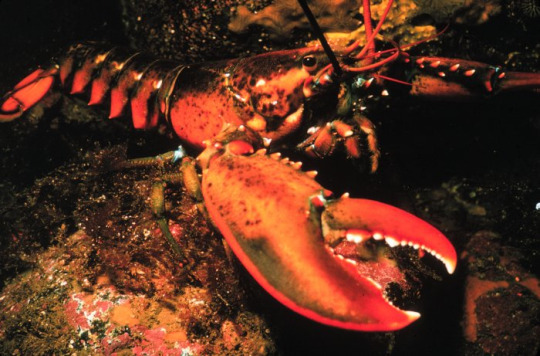
(Photo in Public Domain)
Conservation Status- Least Concern
Habitat- Northwest Atlantic Ocean
Size (Weight/Length)- 60 cm
Diet- Sea urchins; Mollusks; Marine worms; Starfish; Crabs
Cool Facts- While you’re more likely to have an American lobster end up on your plate, not many people know how important they are in their ecosystems. They eat huge amounts of over populated sea urchins that destroy mass areas of kelp reefs. These reefs provide homes for hundreds of species of the fish and the American lobster acts as a guardian alongside sea otters and sheepshead. These lobsters can live up to 100 years old and can weigh more than a human baby. There are strict regulations on the harvesting of American lobsters, mostly regarding the protection of egg carrying females and the massive breeder males.
Rating- 12/10 (Keeping the ocean healthy, one snack at a time.)
#Animal of the day#Animals#Crustacean#Friday#May 19#American lobster#Lobster#biology#science#conservation#the more you know
147 notes
·
View notes
Note
Okay question I know is probably stupid but how do you guys function on only kelp cakes and fish biscuits? I mean Shellington is a otter that needs to eat about 30% of his weight to live and captain barnacles needs about 20% of his body to weight a day to live. Is it like magic? I don't think so but I'm wrong.
(Once again a stupid question but I was curious)
Well, erm, we don't just live on kelp cakes and fish biscuits! We have quite a varied diet.. the Vegimals are adequate chefs. Almost everything they cook comes from the garden pod! And yes, we eat.. a lot. We cook for each other often, too. Soups, sandwiches, pasta and noodles, salads, pancakes, kelp.. pies.. My favorite food is actually a nice clam sandwich. Some of us eat more than others... I eat a lot, and yet I can't seem to gain weight. :/ At least It's not as bad as Peso, his metabolism is lightning fast. I'd have to say Captain Barnacles eats the most out of all of us.
We all take supplements to make up for the lack of meat in our diets. There's also vegan meat, but we don't usually prepare it. We have to take different types of supplements, too.. lots of omega-3s.
I hope this answers your questions! Oh, and also, I don't have to eat thirty percent of my body weight anymore, it's been a couple million years since then.
(I love my Omega-3s.)
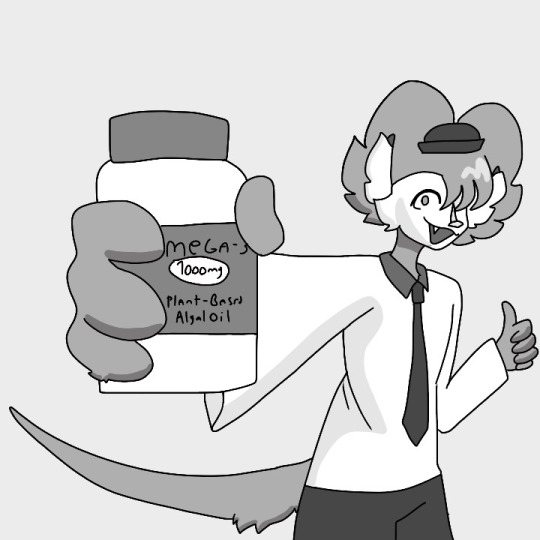
Sincerely,
Dr. Shellington Sea Otter
38 notes
·
View notes
Text
Mercs with an S/O who's a mermaid.
On mobile so beware of typos.
Scout:
He thinks its fuckin' awesome, but he's kinda sad that you can't leave the water for very long.
Kinda has a fear of the ocean/drowning, but it's a bit better when you're with him.
You can swim real fast, and he can run real fast, so collectively you've got land and water covered.
Soldier
Insists that you're in the Navy
Likes to pick you up when you get to shallow waters, and your tail just kinda dangles uselessly out of water
You eat a lot of fish, but his diet is like 90 percent red meat so
Demo
He thinks you are so beautiful, and low key envies how you move so gracefully.
Likes to float around in calm waters and sunbathe with you, kinda like otters. Hold him gently.
He might fall asleep, just make sure you keep his head above water.
Engineer
You communicate with other merpeople kinda like whales, so he's pleasantly surprised when you turn around and speak with him in English.
Not a fan of water- he sinks like a rock, but he'll stay with you at low tide, or in shallow water in general.
Constantly telling you how gorgeous you are
Heavy
He likes swimming with you, and catching you as you swim past
Calls you "little fish" or "медуза" (jellyfish)
Not built for grace, so watching you move always has him mystified
Pyro
Fire and water don't really mix, and they don't like showing skin, so no bathing suits.
Even so, they'll lean down over the side of the boat to nuzzle you.
Encourages you to try breaching, and claps whenever they see you fly out of the water and dive back in.
Sniper
Bring him little things: shells, rocks, sea glass. He'll adore you for this.
The best swimmer of the mercs, so you don't have to worry about him.
Pull him into a kiss under the waves and he will be completely woo'd
Medic
Super curious about your anatomy. Where does the people begin and the fish end? Do you lay eggs, or give live birth? So many questions, but understands if you don't want to answer them
He didn't like swimming a lot before, but does it so he can hold you close.
Once he lost his glasses in the water and you had to dive after them.
Spy
He could sit and stare at you for hours, memorizing you.
It'll take a lot of convincing to get him to get in the water with you.
If he does, though, he'll be handsy, so be warned-
103 notes
·
View notes
Note
Me when the dragon in asks:
Turn an aquatic animal into a dragon. What does it look like, what does it do, and why did you pick it?
Sea otter dragon. They’re long, sinuous, and streamlined, great for swimming, and they have a thick coating of waterproof feathers that insulates them against the cold ocean water. Their wings are small and almost unrecognizable, being used as control surfaces for better underwater maneuverability, and their hands and feet are webbed. They’re relatively small for dragons, a little smaller than a human, colored green and teal to blend in with the kelp forests where they live in large communities. They’re very smart (though not quite on the level of sapience) and playful, tending to be quite amiable towards people, though they don’t hesitate to defend themselves when threatened. Their diet consists mainly of invertebrates like shellfish and squid. Their breath weapon is a jet of superheated water vapor and steam, which is sometimes capable of causing even more severe burns than fire.
As for why I chose them, I think sea otters are a really interesting and unique animal, as well as ecologically important. Plus, they're really cute!
11 notes
·
View notes
Text
Ocean Ranboo August -- 22
Sea Otters are assholes but fuck are they cute assholes

Also, particles look like purple urchins which like a sea otters main diet sooo RIP

13 notes
·
View notes
Text
I'm on a sea otter diet. If I sea otter I eat oter
7 notes
·
View notes
Text
Hmmmmmm..... I may have been hasty confirming common pillbug. Not in the way that I'm not an isopod. I definitely am. But I may be a sea slater actually?
What has me thinking pillbug is that there is a very specific coloration I see myself in. The specificness made me confirm it, I was thinking, I must be this if I was so quickly and easily drawn to this coloration.
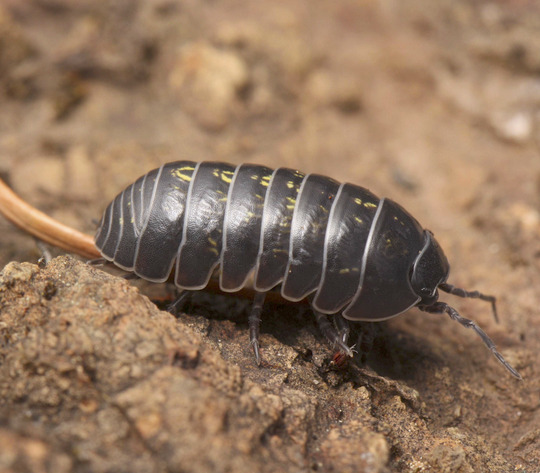
(This is that coloration.)
But so many more things fit with sea slaters. Just by looking at the most common species, Ligia oceanica, the diet fits better, the habitat fits better, and the body plan fits better. It is still a terrestrial woodlouse but is able to swim. Which matches my instincts, though I am still also an otter and a mosasaur, which could be muddying the waters? No pun intended.
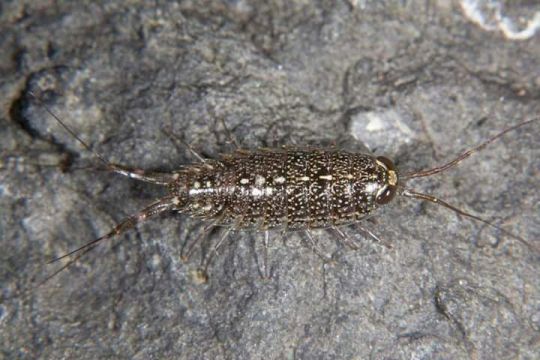
(This pattern kind of appeals to me honestly? This is Ligia exotica.)
I looked at sea slaters at first too but dismissed it, I guess because I've never personally seen them and been able to study the way they move and behave. Pillbugs are everywhere here and one of the few bugs I was comfortable with way back when I used to be entomophobic so I had more of a personal connection with them.
14 notes
·
View notes
Text
Today's Wet Beast Wednesday is about sea otters. I was originally going to do this last week in honor of the 24th birthday of Rosa, the world's oldest sea otter (and one of the oldest sea otters on record) but, well, I forgot. But better late than never.
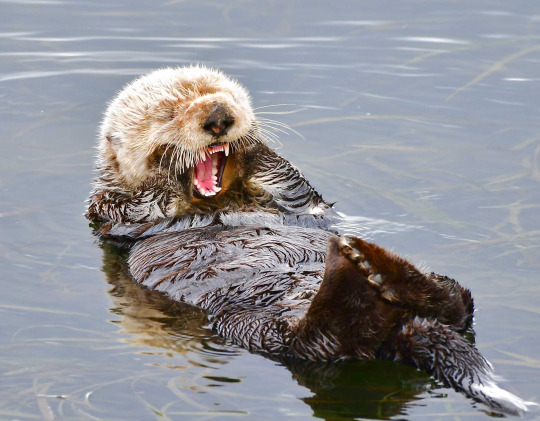
(Image: a sea otter on its back, yawning)
The sea otter (Enhydra lutris) is one of only two otters to live in salt water, the other being the rare and poorly-understood marine otter (Lontra felina). Otters are aquatic mammals of the family Mustelidae, which makes them cousins to weasels, badgers, wolverines, and martens. While many mustelids can swim, otters have adapted to a primarily aquatic lifestyle. Sea otters are divided into three subspecies: the Asian sea otter (Enhydra lutris lutris) which lives from northernmost Japan up through the northwest Pacific, northern sea otter (E. l. kenyoni) which lives from Alaska down to Oregon, and the southern sea otter (E. l. nereis), found in California.
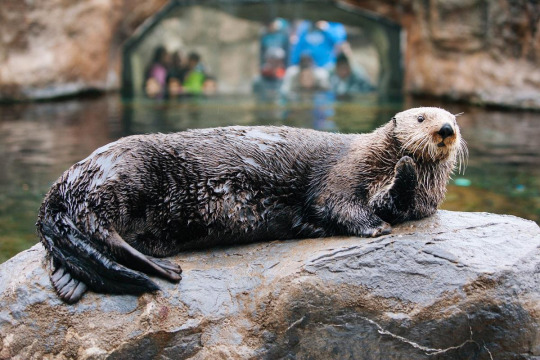
(image: a sea otter relaxing on a rock)
The sea otter is one of the smallest marine mammals (only the marine otter is smaller), yet it is also the heaviest of all mustelids. Males are larger than females, averaging between 1.2 and 1.5 meters (3'11" to 4'11") and 22 to 45 kg (49 to 99 lbs). Females average 1 to 1.4 m (3'3" to 4'7") and 14 to 33 kg (31 to 73 lbs). I honestly thought they were around the size of cats and was surprised to find out how big they can get. Otters are the most recent of the marine mammals and have not developed the thick layer of blubber other marine mammals use to keep themselves warm. Instead, sea otters warm themselves with the densest fur of any mammal, with almost a million hairs per square inch. The fur has two distinct layers: a longer layer of waterproof guard hairs and a shorter underfur layer. The guard hairs keep the underfur dry and trap air between the layers. This air gets heated by the otters body heat and provides an extra layer of insulation. This is the same principle that wet suits work on. The air layer also provides some added buoyancy. Sea otters are positively buoyant and can float on the surface of the water. There are many other adaptations to an aquatic lifestyle that sea otter have. Their feet are webbed and have long digits, allowing them to act as flippers but also making them slower and more clumsy on land. The front claws have retractable claws and pads that let them grab onto slippery objects. When swimming, they use their entire real bodies, but primarily their hind feet, for propulsion. They can hold their breath for up to five minutes and have whiskers used to search for food in darker water. Their ears and nostrils close when submerged to keep water out. While sea otter can, and often do, move around on land, they are capable of living their entire lives in the water. Some evolutionary biologists think sea otters represent an early stage of marine mammal development and can compare them to more established marine mammals like cetaceans and pinnipeds.

(image: a wet weasel holding a sea urchin)
Sea otters are carnivores whose diet consists mostly of hard-shelled invertebrates, though they will also eat fish. They forage for food on the sea floor in dives that usually last a minute. Their paws give them an advantage over other marine mammals, who can only use their mouths for capturing prey. Otters by contrast can pick up and move rocks and dig into the sediment. They are the only marine mammals to catch prey with their paws instead of teeth. Otters carry prey to the surface and eat while floating on their backs. Famously, they use rocks to break open the hard shells of their prey, making them one of the relatively few mammals to use tools (though tool use is proving to be more common than previously thought). Under each arm is a pouch of loose skin that is used to hold prey and rocks. Each otter has a favorite rock that they carry with them. Sea otters have blunt teeth used to crush through prey's shells.

(image: an otter dining on crab)
While sea otters do spend a lot of time in groups, they are not considered truly social animals as they forage, groom, and defend themselves on their own instead of with help. Groups of otters are called rafts that typically have between 10 and 100 members, but can reach up to 2000 members. Rafts are single sex, each having only male or female members. When resting, raft members will hold hands to keep themselves from drifting apart. One social behavior they engage in is play, which is done frequently. Mating season happens in autumn. During summer and autumn, males will attempt to establish territories and push other males out. Females mover between territories at will. Males without territories will swim around and attempt to find females in heat. Males will attempt to mate with multiple females. During estrus, the males and females will bond through play and sometimes aggressive behavior. When mating, the male will bite the female's head, which can leave scars. Otters are capable of delayed embryo implantation, where they can wait for several months between conception and the embryo beginning development. Pregnancy lasts four months and typically results in a single pup. While males are absentee fathers, females are very caring mothers who spend almost all their time caring for their pups. The only time she leaves her pup will be when diving. The pup will be left floating on the surface, often wrapped with kelp to keep it from floating away. The baby will cry for its mother until she comes back. The mother will teach her pup how to dive and forage as it ages. Pups will stay with their mothers for 6 to 8 months (longer in colder areas), and sometimes until they are fully developed. Childless females will foster orphaned pups. Females reach sexual maturity at age 3-4 and males around age 5. They average 10 - 15 years in the wild and can live significantly longer in captivity. The oldest living sea otter is Rosa, living in the Monterey Bay Aquarium, who is 24 years old. The oldest sea otter on record was a female named Etika who lived to be 28.
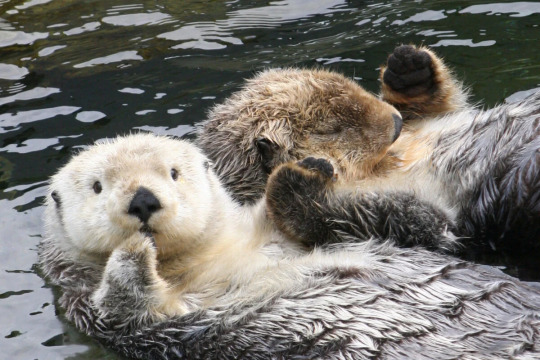
(image: two sea otters holding hands)
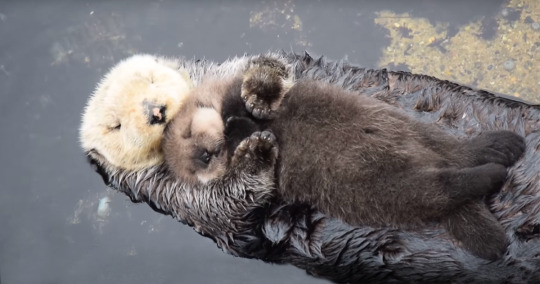
(image: a sea otter mother sleeping with its baby on its stomach)
Sea otters are a classic example of an endangered species. They have been hunted throughout history for their fur. Eventually, this reduced the world population to less than 2000 individuals. They are now the target of conservation measures worldwide and local and international protections, which has helped the population rebound. They still have not regained their historical population or range, though reintroduction measures have helped them reestablish in historical territories. The southern sea otters are the most endangered. Famously, almost all southern sea otters alive today are descended from a group of 50 discovered in 1938, when the subspecies was almost extinct. Sea otters are classified as endangered by the IUCN. Sea otters are a keystone species, having a major ecological impact on their habitats. Famously in California, the near-extinction of southern sea otters resulted in a population boon of sea urchins (their primary prey) which proceeded to kill vast areas of kelp forest. Curren threats include predation, pollution, and habitat loss. Oil spills are particularly devastating to sea otters, as the oil destroys the air layer in their fur, destroying their ability to keep themselves warm.
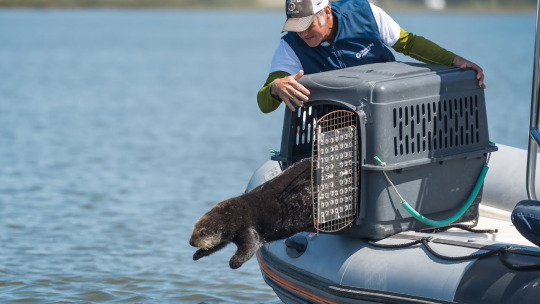
(image: an employee with MBARI releasing a rehabilitated sea otter back into the wild)
#wet beast wednesday#sea otter#otter#marine mammals#wet weasel#water weasel#moist mustelid#marine biology#biology#zoology#ecology#animal facts#adorable
286 notes
·
View notes
Note
The white dots you see after looking at the sun or something bright are actually your white blood cells.
Kangaroos can’t walk backwards
Cans of diet soda float but cans of regular soda sink
Sea otters hold hands while they sleep.
Bees can fly higher than Mt. Everest
Kangaroos can kill you with those fucken talons if I see one I'm getting behind it so it can't attack me
10 notes
·
View notes
Text


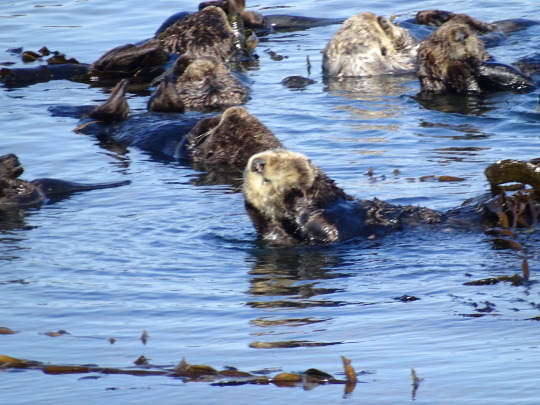


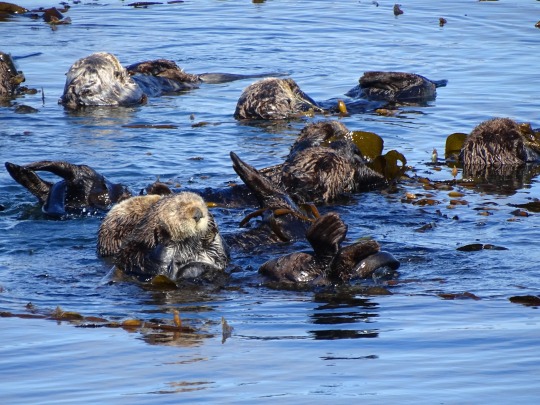


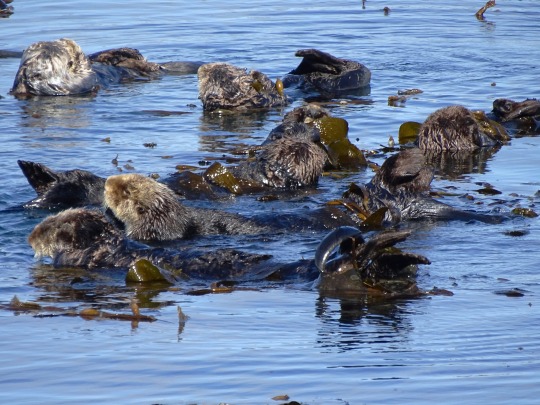
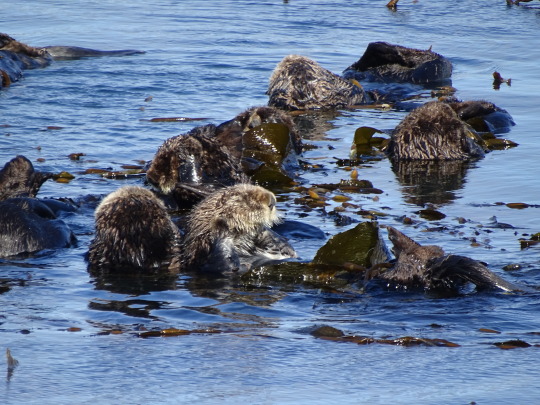
Sea Otter Heaven, Morro Bay (No. 2)
The sea otter (Enhydra lutris) is a marine mammal native to the coasts of the northern and eastern North Pacific Ocean. Adult sea otters typically weigh between 14 and 45 kg (30 and 100 lb), making them the heaviest members of the weasel family, but among the smallest marine mammals. Unlike most marine mammals, the sea otter's primary form of insulation is an exceptionally thick coat of fur, the densest in the animal kingdom. Although it can walk on land, the sea otter is capable of living exclusively in the ocean.
The sea otter inhabits nearshore environments, where it dives to the sea floor to forage. It preys mostly on marine invertebrates such as sea urchins, various mollusks and crustaceans, and some species of fish. Its foraging and eating habits are noteworthy in several respects. Its use of rocks to dislodge prey and to open shells makes it one of the few mammal species to use tools. In most of its range, it is a keystone species, controlling sea urchin populations which would otherwise inflict extensive damage to kelp forest ecosystems. Its diet includes prey species that are also valued by humans as food, leading to conflicts between sea otters and fisheries.
Sea otters, whose numbers were once estimated at 150,000–300,000, were hunted extensively for their fur between 1741 and 1911, and the world population fell to 1,000–2,000 individuals living in a fraction of their historic range. A subsequent international ban on hunting, sea otter conservation efforts, and reintroduction programs into previously populated areas have contributed to numbers rebounding, and the species occupies about two-thirds of its former range. The recovery of the sea otter is considered an important success in marine conservation, although populations in the Aleutian Islands and California have recently declined or have plateaued at depressed levels. For these reasons, the sea otter remains classified as an endangered species.
Source: Wikipedia
#Sea Otter Heaven#California sea otter#Enhydra lutris#Morro Bay#hotel#travel#original photography#vacation#tourist attraction#USA#summer 2022#Califorina#West Coast#San Luis Obispo County#wildlife#animal#seaweed#Morro Rock Ecological Preserve#Pacific Ocean#beach#cityscape#landscape#seascape#kelp#fauna#landmark
2 notes
·
View notes
Text
Synapsic Info
History / Interactions with Humans
Synapsics are an alien race that first descended to earth near the beginning of the Meghalayan age. Their numbers were scarce with only around 50 or lower being alive at a given time. They stayed under the radar for many years, only being found as a separate species in the year 1612. Their low numbers continued to dwindle despite human intervention. In 2604, a second generation descended and the population was saved. Synapsics were recognized as intelligent beings in 2637. Before being discovered by humans, Synapsics would live in small groups in the wild. If they looked humanoid enough they might’ve dwelled in unsuspecting towns or cities. Most had little to no contact with humans, being neither hostile nor friendly. In later years, especially after 2637 and the years following, Synapsics lived alongside humans. Upon being introduced into human society, Synapsics began to attend schools and work at jobs. Many housed with and continue to house with humans in apartments or houses. Human/Synapsic marriage and dating was a highly controversial topic that never really got resolved before the extinction of humans.
Diet / Behaviour
Synapsics are purely carnivorous. Their bodies change to mimic the attributes of its prey whether that be rodents, livestock, or even humans. Their name comes from their main diet being made up of mammals of the Synapsida clade. When a Synapsic hunts for the first time, it will eat whatever it catches for the rest of its life. Due to mostly mimicking mammals, Synapsics are viviparous; meaning live bearing opposed to oviparous which is egg laying. Synapsics rarely reproduce due to their long lifespans of around 150-200 years or by simply having a lack of desire in the act. Some can even live up to 500 years under the right conditions. When they do reproduce however they experience the same gestation period and any other factors that the organism their mimicking would experience.
Subspecies
As Synapsics eat the same prey over and over again, they will develop attributes similar to their meal (Ears, Tail, Fur, Etc.). Subspecies have been given to each morph based on the family, superfamily, or suborder of the mimicked prey.
Tenreform (Tenrecomorpha Suborder | Tenrecs, Shrews)
Caniform (Canidae family | Dogs, Foxes, Wolves)
Ursiform (Ursidae family | Bears)
Mustelform (Musteloidea superfamily | Skunks, Badgers, Weasels, Otters, Racoons, Etc.)
Pinniform (Pinniped clade | Walruses, Seals, Sea lions)
Feliform (Felidae family | Cats (Domestic + Wild)
Vivierrform (Vivierridae family | civets, genets, oyans)
Herpeform (Herpestoidea superfamily | Hyenas, Mongooses, Euplerids)
Tyloform ( Tylopoda suborder | Camels)
Suinaform (Suina suborder | Pigs, Hogs, Peccaries)
Whippoform (Whippomorpha suborder | Hippos, Whales, Dolphins, Etc.)
Rumiform (Ruminantia suborder | Deer, Giraffes, Mooses, Buffalo, Antelope, Gazelle, Sheep, Etc.)
Chiroform (Chiroptera order | Bats)
Cingulaform (Cingulata order | Armadillos)
Didelform (Didelphidae family | Opossums)
Diproform (Diprotodontia order | Kangaroos, Wallabies, Possums, Koalas, Wombats)
Lagoform (Lagomorpha order | Rabbits, Hares, Pikas)
Monotreform (Monotremata order | Platypus, Echidnas)
Perissoform (Perissodactyla order | Horses, Rhinos, Tapirs)
Piloform (Pilosa order | Sloths, Anteaters)
Hominiform (Hominidae family | Humans, Chimps, Gorillas, Etc.)
Strepsiform (Strepsirrhini suborder | Lemurs, Bushbabies, Galagos, Lorises)
Elephform (Elephantidae family | Elephants)
Castoriform (Castorimorpha suborder | Beavers, Gophers, Pocket Mice)
Myoform (Myomorpha suborder | Jerboas, Mice, Voles, Rats, Hamsters)
Sciuroform (Sciuromorpha suborder | Dormice, Squirrels)
Scandentiform (Scandentia order | Treeshrews)
Sireform (Sirenia order | Dugongs, Manatees)
Orycteroform (Orycteropodidae family | Aardvarks)
#roblox#roblox flicker#robloxflicker#flicker#flicker roblox#flicker au#original species#infodump#personal essay
4 notes
·
View notes
Note
I got the name courtesy of @tysonfurybattlepass
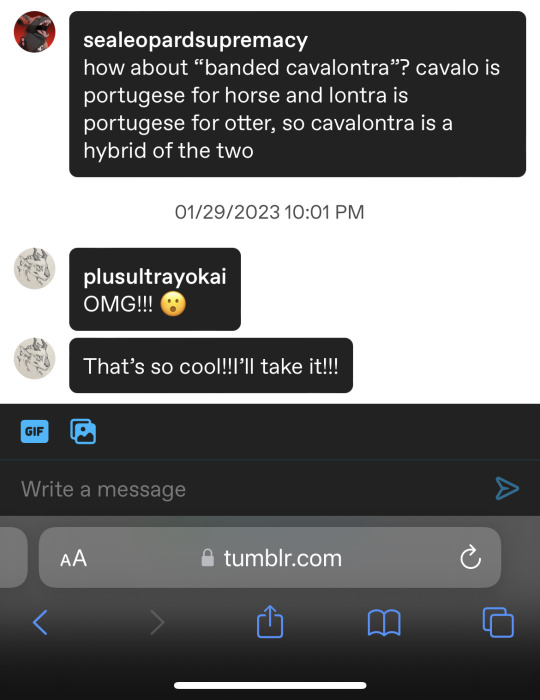
Banded Cavalontra.

Despite looking like a large bear with odd legs, this animal’s design is a cross between a land and sea otter, a dolphin, as well as a Galápagos penguin and a prehistoric ancestor to the whale. It’s limbs, while seemingly built for land-only locomotion, has webbed toes, as well as two large webs between their front legs, acting as flippers when in the water along with their tail.
(What their tail looks like. It would drag on the ground when walking on land)
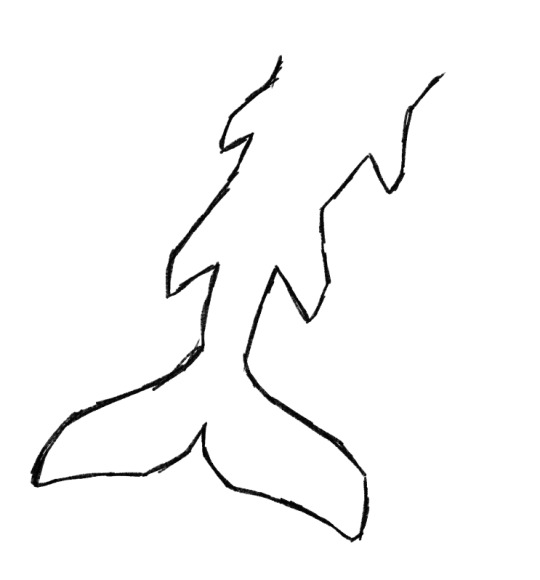
They have featherlike fur, which has the pattern of a combination of a bottlenose dolphin and a Galápagos penguin. Cavalontra come in different colors, and can actually be rode like horses, but you have to earn its trust in order to ride it. It has a saddle that resembles a harness, and that it looks like a combination of there two images below👇


The horn is inverted however, so that it can pull ropes binding larger megafauna, such as leviathan.Concerning its diet, Cavalontra are omnivores, being able to dive for ocean plants, as well as crack open crustacean shells with their molars, and shred fish and crustacean flesh with their incisors and canines, but can also use them for self defense against predators or other threats. Its fur also varies in density, being thicker the colder the environment is. They’re friendly to most creatures and people who don’t pose a threat to them or their young, but when two rival males are up against each other, or if a mother senses hostility to either her or her young, a Cavalontra can cause serious injuries.
(Also can you draw what they look like pls? I tried to draw one to the best of my abilities.I wonder if I can use the drawing you made of the Banded Cavalontra to help improve my drawing and anatomy skills)
your worldbuilding is really great, i love how much thought you put into it!
as for a drawing of your Banded Cavalontra, I hope this one works for you! I'm not an expert on saddles, but I think this one looks alright haha.

(image description: an otter-like creature with a long finned tail, wearing a small simple saddle. It is a dark grey on top and a pale beige underneath, with the dark grey also coming around it's neck and cheeks. end description.)
11 notes
·
View notes